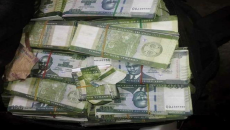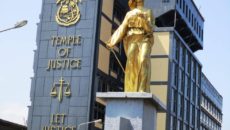“$100 Million in Cash Vanishes in Liberia, and Fingers Start Pointing†— That was The New York Times’ headline last September, one of many articles around the world covering the disappearance of millions of newly minted dollars shipped from Sweden to Liberia between 2016 and 2018. News reports frequently referenced a missing container of banknotes. Indeed, fingers did point. Fifteen “persons of interest,†including Milton Weeks and Charles Sirleaf, were barred from travel.
Since then, several investigations were conducted by the Liberia National Police, the National Security Agency, and a newly formed Presidential Investigative Team which included members from the aforementioned organizations as well as the Financial Intelligence Unit of Liberia and the Liberia Anti-Corruption Commission. After an internal investigation of its own, the executive governor of the Central Bank of Liberia, Nathaniel Patray, proclaimed that all L$15.506 billion of the shipment of new banknotes had been placed in the Central Bank’s reserve vaults.
To get to the bottom of the matter, and prompted by public protests, the Government of Liberia went to the U.S. Embassy in Liberia seeking an independent investigation. The embassy, through USAID, contracted Kroll Associates Inc., an independent forensic investigation firm, “to research matters stemming from allegations in the press that a container of new Liberian Dollar banknotes had ‘gone missing’ upon arrival in Liberia.†Kroll’s Independent Review Report was published on February 28, 2019.
Kroll analyzed delivery documentation provided by the Central Bank of Liberia, confirming that L$15.506 billion in new banknotes were received into the Central Bank’s reserve vaults. Allegations that a container of banknotes had vanished appear were not confirmed by the analysis.
Crisis averted? Not so fast. The 67-page Kroll report reveals a series of significant missteps at just about every point in the process, raises serious concerns about the Central Bank of Liberia’s internal record-keeping, and says that L$6.387 billion worth of new banknotes were potentially injected into the Liberian economy without legislative approval (that alone has its own set of serious consequences).
So, let’s take a look at some of Kroll’s findings.
Discrepancies, Discrepancies, Discrepancies
Everywhere you look, this report notes multiple discrepancies from the Central Bank failing to follow its own procurement process and awarding contracts prior to receiving legislative approval to the quantity and value of banknotes shipped and delivered. There were weight variances from one airbill to the next, overpayments for printing and a failure to deduct for currency not printed. Other discrepancies included using the currency for unintended purposes, and there were cash discrepancies between vault balances and ledgers, to name a few.
In addition to all of the discrepancies, Kroll noted the extensive use of handwritten forms, a lack of checks and balances, and an “inaccurate and incomplete nature of the documentation provided by the CBL to Kroll during the independent review.â€
Doing it Our Way
One of the key findings is that the Central Bank of Liberia entered into contracts for the printing of currency prior to Legislature approval, which is clearly unconstitutional under sub-section (ii) of Article 34d of the constitution which states:
The Legislature shall have the power to levy taxes, duties, imposts, excise, and other revenues, to borrow money, issue currency, mint coins, and to make appropriations for the fiscal governance of the Republic, subject to the following qualifications:
(ii) no monies shall be drawn from the treasury except in consequence of appropriations made by legislative enactment and upon warrant of the President; and no coin shall be minted, or national currency issued except by the expressed authority of the Legislature. An annual statement and account of the receipt and expenditure of all public monies shall be submitted by the office of the President to the Legislature and published once a year; and…
The Central Bank of Liberia has an established procurement process requiring multiple bids but appears not to have followed it. The company that was awarded the contract, Crane AB, does not have a formal bid on file — at least Kroll was never given documentation of it. Individuals from Crane AB were introduced to those from the Central Bank via a personal introduction from a commercial banking contact. While two other vendors had been referenced, Kroll found no evidence of any other submitted bids.
In fact, in a “special called meeting†resulting in a Board of Governors resolution confirming the selection of Crane AB as the vendor, the resolution mentions detailed presentations by Crane AB and two other international currency printing vendors, but the actual signed minutes from the meeting say absolutely nothing about any presentations nor the approval of any banknote printing contract.
In total, two contracts, one for L$5 billion and the other for L$10 billion, were awarded to Crane AB. The first had a clause allowing for a print fluctuation of +/- 1.5 percent to account for the practicalities of printing banknotes (the second didn’t have this clause). The actual fluctuation was much higher and does not appear to have been disputed by the Central Bank. For the first contract, the actual fluctuation came to 5.11 percent for an overage of L$146,250,000. The second contract had a more reasonable fluctuation of 1.2 percent for a L$359,750,000 overage. That’s a combined total of L$506,000,000 of undisputed extra currency.
Shipping and Delivery Discrepancies
Multiple pages covered numerous shipping and delivery discrepancies. Kroll ultimately concluded that the total value of new banknotes shipped by Crane AB to Liberia between July 2016 to March 2018 totaled L$15.506 billion, which is the contracted amount plus the overage amount. However, documentation provided by the Central Bank (accounting for appended packing lists from Crane AB puts the total value of new banknotes shipped by Crane AB to Liberia between July 2016 to March 2018 at L$17.450 billion, which would equate to over-printing of new banknotes totaling L$1.944 billion. The report notes that “this discrepancy merits further understanding.â€
Doing it Our Way Again
Kroll also found that the money was not used for its intended purpose. In one example, a separate operation involving the injection of US$25 million into the economy under the Weah administration was launched in 2018. This so-called “USD mop up exercise†was intended to mop up excess Liberian banknotes in response to a steep rise in exchange rates. Of the US$25 million approved, US$5 million was not withdrawn and another US$5 million went into general circulation as part of normal banking operations.
Kroll found multiple cash count discrepancies related to this operation and the two contracts being discussed. In one of several examples, Kroll’s independent physical cash verification count identified an unreconciled difference of L$21,210,579 between general ledger account (Bk Notes in Vault & Cash) and the value of operational banknotes in Operational Vault 3. It also noted inadequate controls over banknote storage and observed loose bank notes in the vault that may or may not have been accounted for in the general ledger.
As part of its look into the mop-up exercise and cash counts, Kroll discovered a separate concern regarding the intended purpose of new banknotes from the second contract (the one for the L$10 billion). When the Legislature approved the contract (after it had already been awarded), it stated that all legacy banknotes should be replaced with new banknotes in the Liberian economy. After analyzing the data concerning the legacy banknotes that had been destroyed or were awaiting destruction) during the time when the new banknotes from the second contract had been circulated, it found that L$2.915 billion had been destroyed or were awaiting destruction. However, during that same time, L$9.302 billion of new banknotes from the second contract had been circulated.
This means that all of the new banknotes were not used for their intended purpose of replacing legacy banknotes. It also means that L$6.387 billion was potentially injected into the Liberian economy by the Central Bank without Legislative approval.
What Does This All Mean?
The investigation identified systemic and procedural weaknesses at the Central Bank of Liberia as well as long-standing shortcomings in Liberia’s fiscal and monetary management processes that continue today. The Central Bank appears to be doing business in its own way, ignoring the constitution and using the money for purposes other than intended. Its cash vaults and ledgers do not match up, its systems include handwritten forms that are easy to manipulate, its documentation is inaccurate and incomplete, manually created reports were given to Kroll because automated reports were not available from the Central Bank’s internal systems, and it appears there are more issues that need further investigation. For example, what’s the story behind the L$1.944 billion discrepancy that merits further understanding?
The fact that L$6.3 billion has entered the Liberian economy without forethought or approval is huge. According to Kroll,
The increase of banknotes in circulation may be a factor in the current rate of inflation in Liberia. An International Monetary Fund press release in March 2018 stated that ‘…inflation, which at 14 percent, remains at a relatively elevated level.’ Kroll understands that the rate of inflation (as at January 31, 2019) is approximately 25%. Further, the increase of banknotes in circulation may be a factor in the rapid depreciation of the LRD exchange rate between January 2018 and July 2018.
The Kroll report details all of the above and more. One thing it doesn’t do is point fingers. We know the entire system in Liberia is in dire need of improvement, but the report failed to hold anyone personally accountable. It feels as though Kroll is trying to play it safe and avoid creating a problem in Liberia (which is understandable). However, we can’t continue to blame the system in a vacuum. For example, in the United States, the Mueller investigation is pointing fingers at individuals and has led to 199 criminal charges, 37 indictments or guilty pleas, and 5 prison sentences — and counting. Only a handful of elected or appointed individuals are named in the Kroll report, and those instances are not necessarily instances of finger-pointing.
If you have a couple of hours to spare and want to learn more, it is worth reading the Kroll report in its entirety by downloading it at: https://www.usaid.gov/liberia/newsroom/missing-currency-report.
Featured photo by Jefferson Krua



